How Industrial Transfer Processes Impact on Haze Pollution in China: An Analysis from the Perspective of Spatial Effects
Abstract
:1. Introduction
2. Literature Review
3. Methodology and Data
3.1. Methodology
3.2. Variables and Data
3.2.1. Interpreted Variable
3.2.2. Explanatory Variables
3.2.3. Control Variables
3.2.4. Sample Selection and Data Sources
3.3. Descriptive Statistics of Variables
3.4. Framework of This Research
4. Results and Discussion
4.1. Variation Trend of Industrial Transfer and Haze Pollution
4.2. Impact of Industrial Transfer on Haze Pollution
4.3. Further Analysis
4.4. Robustness Test
5. Conclusions
Author Contributions
Funding
Conflicts of Interest
References
- Dong, F.; Bina, Z.; Yu, B.; Wang, Y.; Zhang, S.; Li, J.; Su, B.; Long, R. Can land urbanization help to achieve CO2 intensity reduction target or hinder it? Evidence from China. Resour. Conserv. Recycl. 2018, 134, 206–215. [Google Scholar] [CrossRef]
- Du, G.; Liu, S.; Lei, N.; Huang, Y. A test of environmental Kuznets curve for haze pollution in China: Evidence from the penal data of 27 capital cities. J. Clean. Prod. 2018, 205, 821–827. [Google Scholar] [CrossRef]
- Ji, X.; Yao, Y.; Long, X. What causes PM2.5 pollution? Cross-economy empirical analysis form socioeconomic perspective. Energy Policy 2018, 119, 458–472. [Google Scholar] [CrossRef]
- Bell, M.; Ebisu, K.; Leaderer, B.; Gent, J.; Lee, H.; Koutrakis, P.; Peng, R. Associations of PM2.5 constituents and sources with hospital admissions: Analysis of four counties in Connecticut and Massachusetts (USA) for person’s ≥65 years of age. Environ. Health Perspect. 2014, 122, 138–144. [Google Scholar] [CrossRef] [PubMed]
- Word Health Organization. Air Quality Guidelines: Global Update 2005: Particulate Matter, Ozone, Nitrogrn Dioxide, and Sulfur Dioxide; World Health Organization: Geneva, Switzerland, 2006. [Google Scholar]
- Mu, Q.; Zhang, S. An evaluation of the economic loss due to the heavy haze during January 2013 in China. China Environ. Sci. 2013, 33, 2087–2094. (In Chinese) [Google Scholar]
- Chen, L.; Xu, L.; Yang, Z. Accounting carbon emission changes under regional industrial transfer in an urban agglomeration in China’s Pearl River Delta. J. Clean. Prod. 2017, 167, 110–119. [Google Scholar] [CrossRef]
- Zhang, P.; Zhang, L.; Tian, X.; Hao, Y.; Wang, C. Urban energy transition in china: Insights from trends, socioeconomic drivers, and environmental impacts of Beijing. Energy Policy 2018, 117, 173–183. [Google Scholar] [CrossRef]
- Liu, L.; Wang, K.; Wang, S.; Zhang, R.; Tang, X. Assessing energy consumption, CO2 and pollutant emissions and health benefits from China’s transport sector through 2050. Energy Policy 2018, 116, 382–392. [Google Scholar] [CrossRef]
- Dong, F.; Wang, Y.; Su, B.; Hua, Y.; Zhang, Y. The process of peak CO2 emissions in developed economies: A perspective of industrialization and urbanization. Resour. Conserv. Recycl. 2019, 141, 61–75. [Google Scholar] [CrossRef]
- Yin, H.; Pizzol, M.; Jacobsen, J.; Xu, L. Contingent valuation of health and mood impacts of PM2.5, in Beijing, China. Sci. Total Environ. 2018, 630, 1269–1282. [Google Scholar] [CrossRef]
- Dong, F.; Dai, Y.; Zhang, S.; Zhang, X.; Long, R. Can a carbon emission trading scheme generate the Porter effect? Evidence from pilot areas in China. Sci. Total Environ. 2019, 653, 565–577. [Google Scholar] [CrossRef] [PubMed]
- The State Council of the People’s Republic of China. The State Council of the People’s Republic of China Air Pollution Prevention and Control Action Plan. Available online: http://www.gov.cn/zwgk/2013-09/12/content_2486773.htm (accessed on 12 September 2013). (In Chinese)
- Yin, J.; Zheng, M.; Li, X. Interregional transfer of polluting industries: A consumption responsibility perspective. J. Clean. Prod. 2016, 112, 4318–4328. [Google Scholar] [CrossRef]
- Chen, D.; Chen, S. Particulate air pollution and real estate valuation: Evidence from 286 Chinese prefecture-level cities over 2004–2013. Energy Policy 2017, 109, 884–897. [Google Scholar] [CrossRef]
- Yuan, X. Inter-provincial trade, international trade and economic growth. Financ. Trade Econ. 2013, 410, 95–102. [Google Scholar]
- Cagno, E.; Trianni, A.; Worrell, E.; Miggiano, F. Barriers and drivers for energy efficiency: Different perspectives from an exploratory study in the Netherlands. Energy Procedia 2014, 61, 1256–1260. [Google Scholar] [CrossRef]
- Zhu, E. Efforts to Promote the Beijing-Tianjin-Hebei Ecological and Environmental Integration. China Environmental News, 11 July 2016; 003. [Google Scholar]
- Dou, J.; Shen, Y. On the influence of the industrial transfer on the environment in the central region of China. China Popul. Resour. Environ. 2014, 24, 96–102. (In Chinese) [Google Scholar]
- Copeland, B.; Taylor, M. North-south trade and the environment. Q. J. Econ. 1994, 109, 755–787. [Google Scholar] [CrossRef]
- Cole, M.; Elliott, R.; Fredriksson, P. Endogenous pollution havens: Does FDI influence environmental regulations? Scand. J. Econ. 2006, 108, 157–178. [Google Scholar] [CrossRef]
- List, J.A.; Millimet, D.L.; Fredriksson, P.G.; McHone, W.W. Effects of environmental regulations on manufacturing plant births: Evidence from a propensity score matching estimator. Rev. Econ. Stat. 2003, 85, 944–952. [Google Scholar] [CrossRef]
- Liang, F. Does foreign direct investment harm the host country’s environment? Evidence from China. Curr. Top. Manag. 2014, 17, 101–121. [Google Scholar] [CrossRef]
- Deng, Y.; Xu, H. Foreign direct investment, agglomeration externalities and environmental pollution. Stat. Res. 2016, 33, 47–54. (In Chinese) [Google Scholar]
- Liu, Q.; Wang, S.; Zhang, W.; Zhang, W.; Zhan, D.; Li, J. Does foreign direct investment affect environmental pollution in China’s cities? A spatial econometric perspective. Sci. Total Environ. 2018, 613–614, 521–529. [Google Scholar] [CrossRef] [PubMed]
- Zheng, W.; Wang, X.; Tian, D.; Jian, S.; Andersen, M.; He, G.; Crabbe, M.; Zheng, Y.; Zhong, Y.; Qu, W. Water pollutant fingerprinting tracks recent industrial transfer from coastal to inland China: A case study. Sci. Rep. 2013, 3, 1031. [Google Scholar] [CrossRef] [PubMed]
- Lin, B.; Zou, C.Y. Changes in developmental stage and environmental policy options in China. Soc. Sci. China 2014, 5, 81–95. (In Chinese) [Google Scholar]
- Zhang, C.; Guo, Y. Can pollution-intensive industry transfer achieve win-win development in economy and environment? From the perspective of environment regulation. J. Financ. Econ. 2015, 41, 96–108. (In Chinese) [Google Scholar]
- Xu, J.; Zhang, M.; Zhou, M.; Li, H. An empirical study on the dynamic effect of regional industrial carbon transfer in China. Ecol. Indic. 2017, 73, 1–10. [Google Scholar] [CrossRef]
- Sancho, F. Double dividend effectiveness of energy tax policies and the elasticity of substitution: A CGE appraisal. Energy Policy 2010, 38, 2927–2933. [Google Scholar] [CrossRef]
- Xu, Y.; Masui, T. Local air pollutant emission reduction and ancillary carbon benefits of SO2 control policies: Application of AIM/CGE model to China. Eur. J. Oper. Res. 2009, 198, 315–325. [Google Scholar] [CrossRef]
- Allan, G.; Lecca, P.; Mcgregor, P.; Swales, K. The economic and environmental impact of a carbon tax for Scotland: A computable general equilibrium analysis. Ecol. Econ. 2014, 100, 40–50. [Google Scholar] [CrossRef]
- Li, Y.; Su, B. The impacts of carbon pricing on coastal megacities: A CGE analysis of Singapore. J. Clean. Prod. 2017, 165, 1239–1248. [Google Scholar] [CrossRef]
- Leng, Y.; Xian, G.; Du, S. Foreign direct investment and haze pollution: An empirical analysis based on provincial panel data. J. Int. Trade 2015, 12, 74–84. (In Chinese) [Google Scholar]
- Li, L.; Tang, D.; Sun, Y.; Liu, D.; Yang, Y. A spatial econometric analysis of impact of FDI on urban haze pollution-case of the Pearl River Delta Region. Manag. Rev. 2016, 28, 11–24. (In Chinese) [Google Scholar]
- Mátyás, L.; Sevestre, P. The Econometrics of Panel Data: Fundamentals and Recent Developments in Theory and Practice; Springer: Berlin, Germany, 2008. [Google Scholar]
- Lesage, J.; Pace, R. Introduction to Spatial Econometrics; CRC Press: Boca Raton, FL, USA, 2009. [Google Scholar]
- Buettner, T. Local business taxation and competition for capital: The choice of the tax rate. Reg. Sci. Urban Econ. 2001, 31, 215–245. [Google Scholar] [CrossRef]
- Case, A. Interstate tax competition after tra86. J. Policy Anal. Manag. 1993, 12, 136–148. [Google Scholar] [CrossRef]
- Federico, R. Spatial patterns in local taxation: Tax mimicking or error mimicking? Appl. Econ. 2001, 33, 1101–1107. [Google Scholar]
- Heyndels, B.; Vuchelen, J. Tax mimicking among Belgian municipalities. Natl. Tax J. 1998, 51, 89–101. [Google Scholar]
- Ladd, H. Mimicking of Local Tax Burden Among Neighboring Counties. Public Financ. Q. 1992, 20, 450–467. [Google Scholar] [CrossRef]
- Besley, T.; Case, A. Incumbent behavior: Vote-seeking, tax-setting, and yardstick competition. Am. Econ. Rev. 1995, 85, 25–45. [Google Scholar]
- Brueckner, J.; Saavedra, L. Do local governments engage in strategic property-tax competition? Natl. Tax J. 2001, 54, 203–229. [Google Scholar] [CrossRef]
- Bordignon, M.; Cerniglia, F.; Revelli, F. In search of yardstick competition: A spatial analysis of Italian municipality property tax setting. J. Urban Econ. 2004, 54, 199–217. [Google Scholar] [CrossRef]
- Büttner, T. Determinants of tax rates in local capital income taxation: A theoretical model and evidence from Germany. Finanzarchiv 1999, 56, 363–388. [Google Scholar]
- Zhang, Y.; Lang, J.; Cheng, S.; Li, S.; Zhou, Y.; Chen, D.; Zhang, H.; Wang, H. Chemical composition and sources of PM1, and PM2.5, in Beijing in autumn. Sci. Total Environ. 2018, 630, 72–82. [Google Scholar] [CrossRef] [PubMed]
- Yuan, Z.; Shi, L. Improving enterprise competitive advantage with industrial symbiosis: Case study of a smeltery in China. J. Clean. Prod. 2009, 17, 1295–1302. [Google Scholar] [CrossRef]
- Shao, S.; Li, X.; Cao, J.; Yang, L. China’s economic policy choices for governing smog pollution based on spatial spillover effects. Econ. Res. J. 2016, 51, 73–88. (In Chinese) [Google Scholar]
- Dong, F.; Long, R.; Li, Z.; Dai, Y. Analysis of carbon emission intensity, urbanization and energy mix: Evidence from China. Nat. Hazards 2016, 82, 1–17. [Google Scholar] [CrossRef]
- Heinberg, R.; Fridley, D. The end of cheap coal. Nature 2010, 468, 367–369. [Google Scholar] [CrossRef] [PubMed]
- Liu, Z.; Guan, D.; Crawford-Brown, D.; Zhang, Q.; He, K.; Liu, J. A low-carbon road map for China. Nature 2013, 500, 143–145. [Google Scholar] [CrossRef]
- Dong, F.; Long, R.; Yu, B.; Wang, Y.; Li, J.; Wang, Y.; Dai, Y.; Yang, Q.; Chen, H. How can china allocate CO2, reduction targets at the provincial level considering both equity and efficiency? Evidence from its Copenhagen accord pledge. Resour. Conserv. Recycl. 2018, 130, 31–43. [Google Scholar] [CrossRef]
- Shao, S.; Yang, L.; Yu, M. Estimation, characteristics, and determinants of energy-related industrial CO2 emissions in Shanghai (China), 1994–2009. Energy Policy 2011, 39, 6476–6494. [Google Scholar] [CrossRef]
- Yang, M.; Ma, T.; Sun, C. Evaluating the impact of urban traffic investment on SO2 emissions in China cities. Energy Policy 2018, 113, 20–27. [Google Scholar] [CrossRef]
- Sun, C.; Luo, Y.; Li, J. Urban traffic infrastructure investment and air pollution: Evidence from the 83 cities in China. J. Clean. Prod. 2018, 172, 488–496. [Google Scholar] [CrossRef]
- Camison, C. Effects of coercive regulation versus voluntary and cooperative auto-regulation on environmental adaptation and performance: Empirical evidence in Spain. Eur. Manag. J. 2010, 28, 346–361. [Google Scholar] [CrossRef]
- Feres, J.; Reynaud, A. Assessing the impact of formal and informal regulations on environmental and economic performance of Brazilian manufacturing firms. Environ. Resour. Econ. 2012, 52, 65–85. [Google Scholar] [CrossRef]
- Wheeler, D. Racing to the bottom? Foreign investment and air pollution in developing countries. J. Environ. Dev. 2001, 10, 225–245. [Google Scholar] [CrossRef]
- Li, K.; Lin, B. Impacts of urbanization and industrialization on energy consumption/CO2 emissions: Does the level of development matter? Renew. Sustain. Energy Rev. 2015, 52, 1107–1122. [Google Scholar] [CrossRef]
- Dong, F.; Yu, B.; Hadachin, T.; Dai, Y.; Wang, Y.; Zhang, S.; Long, R. Drivers of carbon emission intensity change in China. Resour. Conserv. Recycl. 2018, 129, 187–201. [Google Scholar] [CrossRef]
- Yoo, J.; Lee, Y.; Kim, D.; Jeong, M.; Stockwell, W.; Kundu, P.; Oh, S.; Shin, D.; Lee, S. New indices for wet scavenging of air pollutants (O3, CO, NO2, SO2, and PM10) by summertime rain. Atmos. Environ. 2014, 82, 226–237. [Google Scholar] [CrossRef]
- Kimura, F.; Kimura, S.; Chang, Y.; Li, Y. Financing renewable energy in the developing countries of the East Asia Summit region: Introduction. Energy Policy 2016, 95, 421–426. [Google Scholar] [CrossRef]
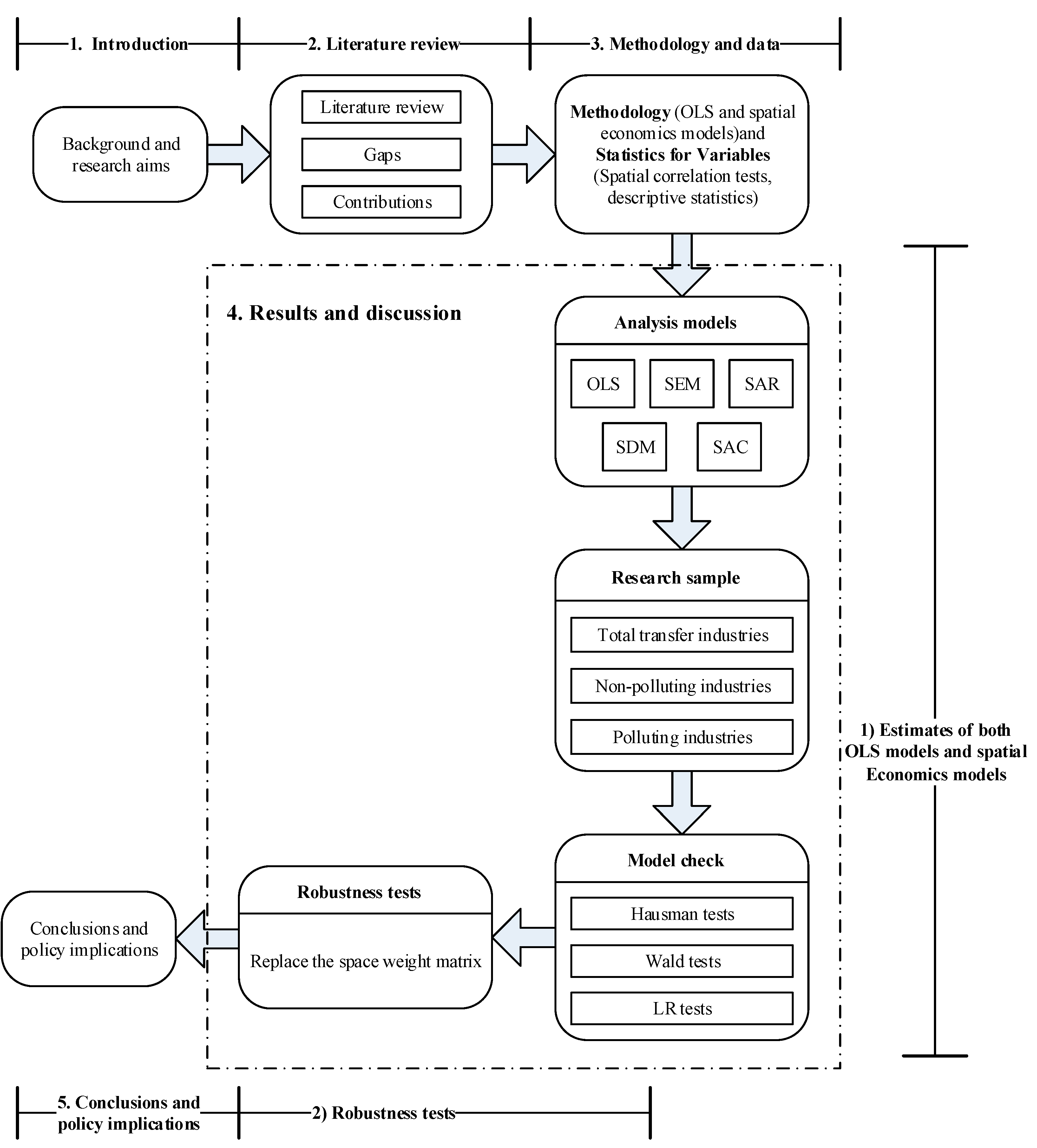
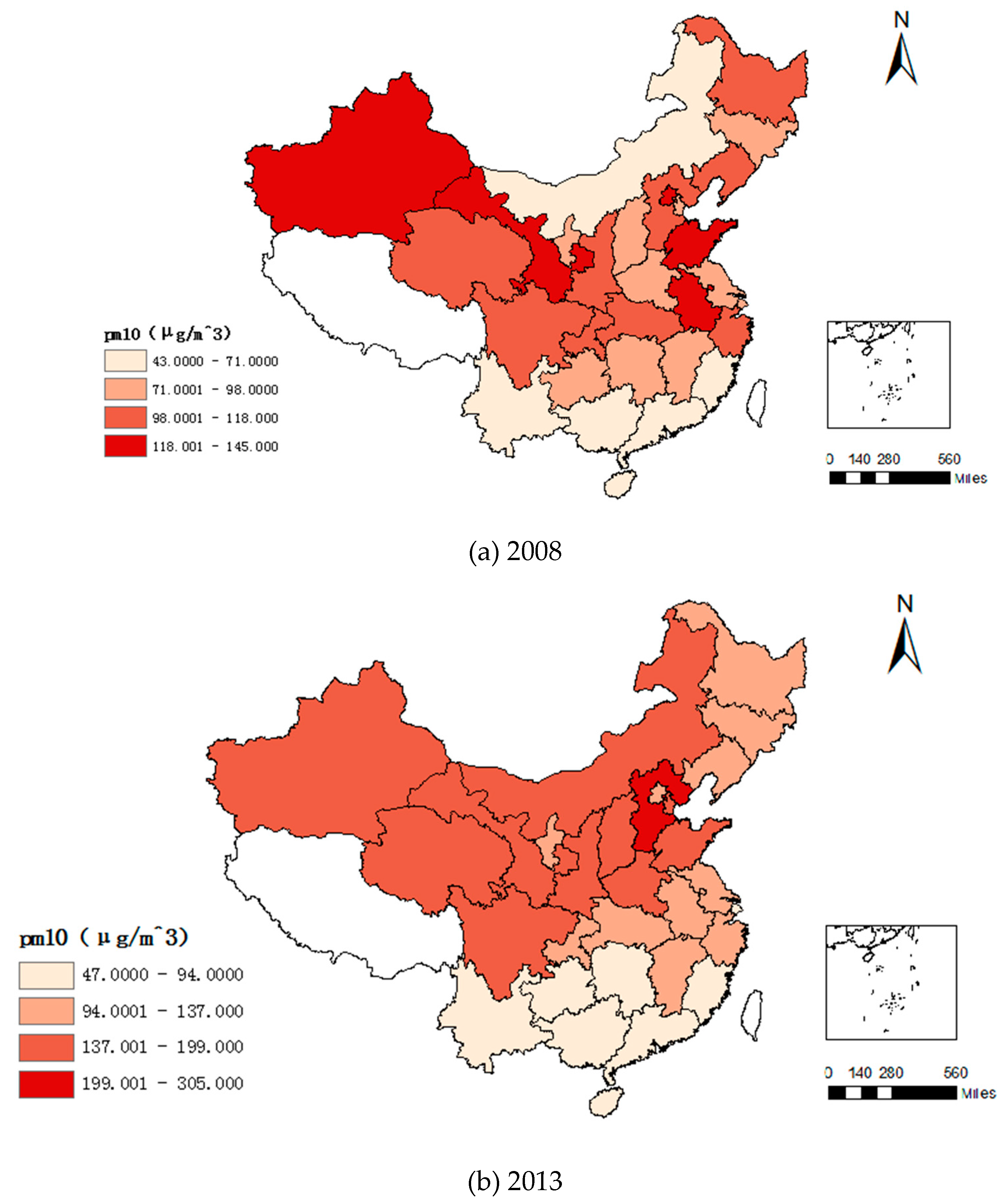
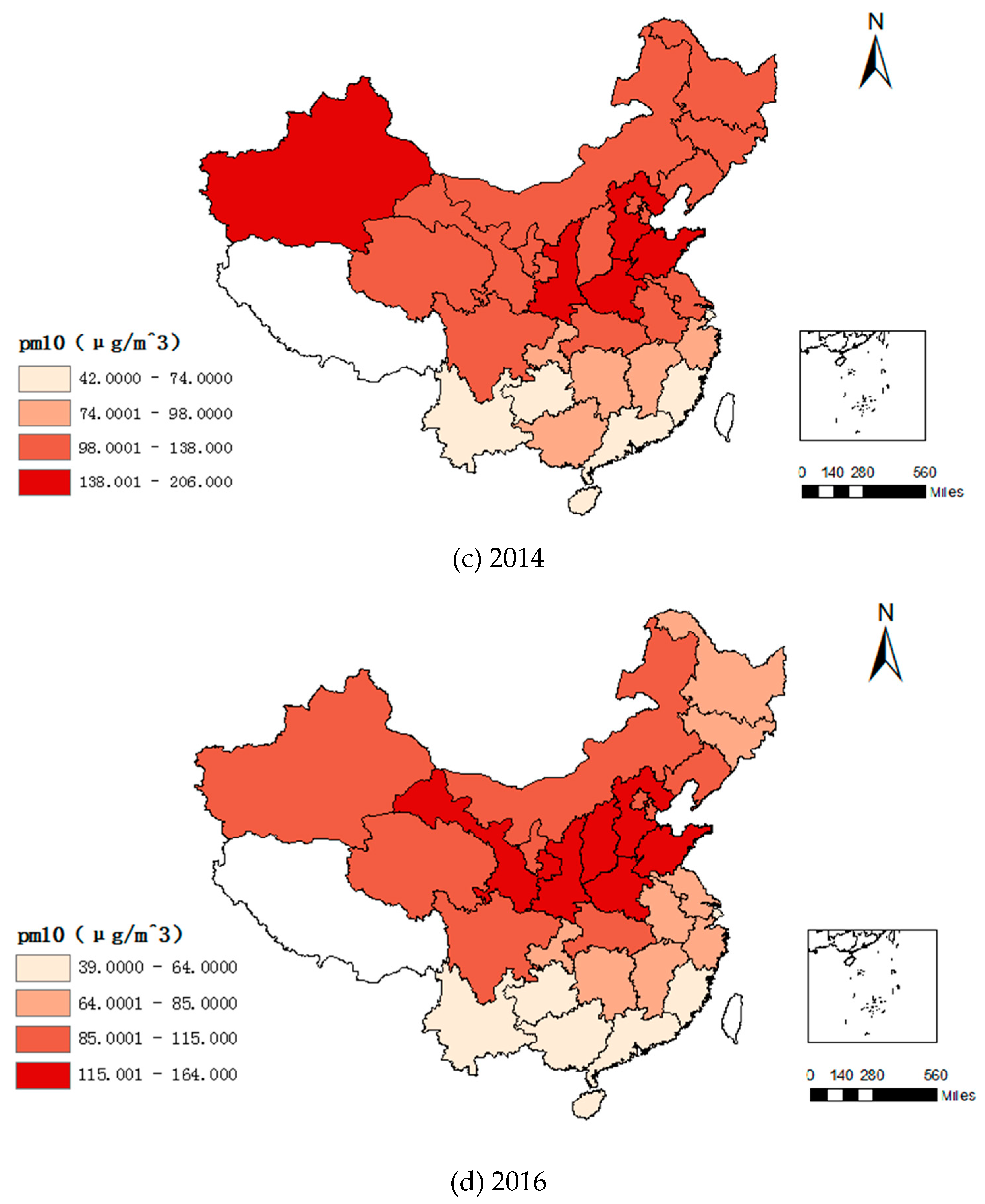
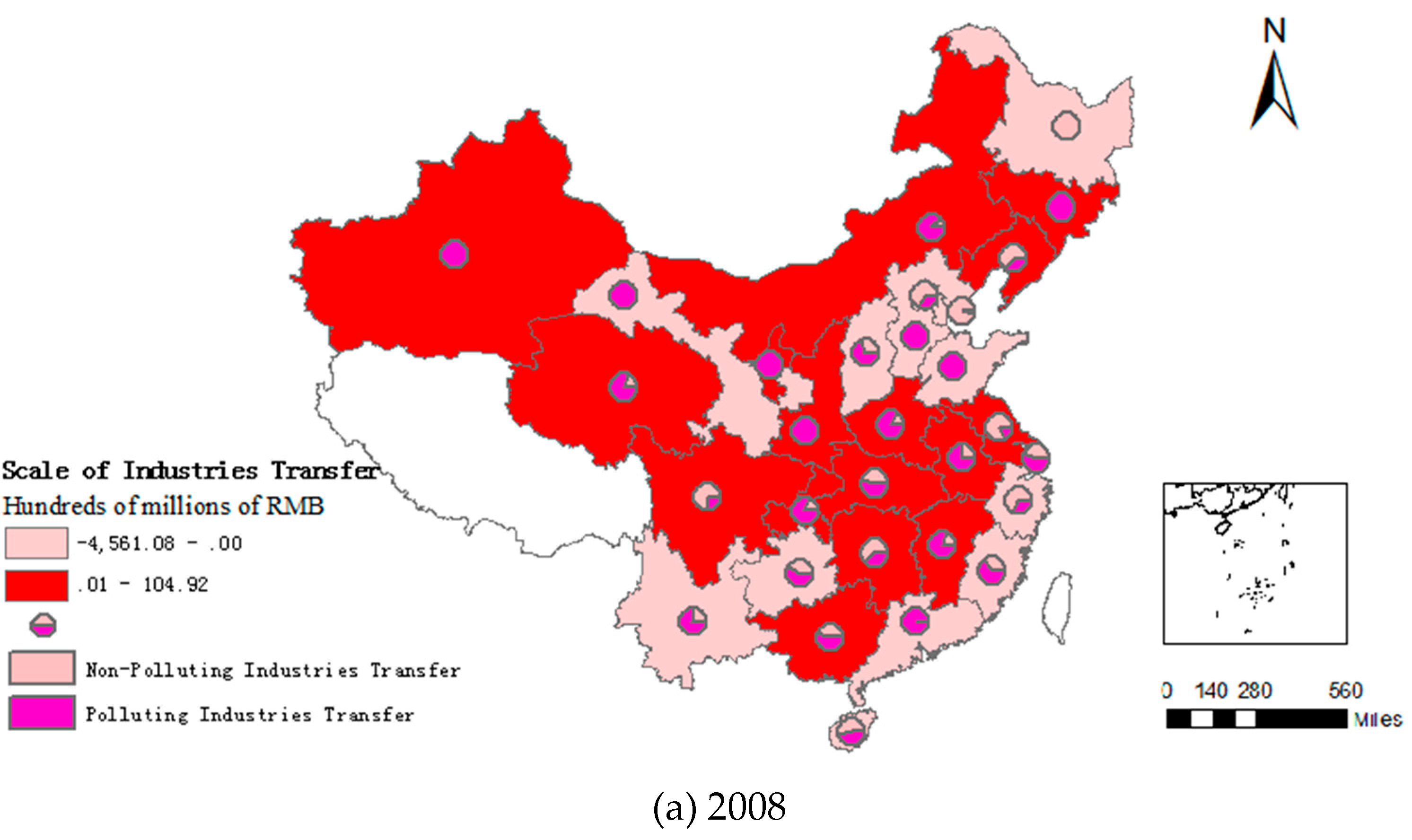
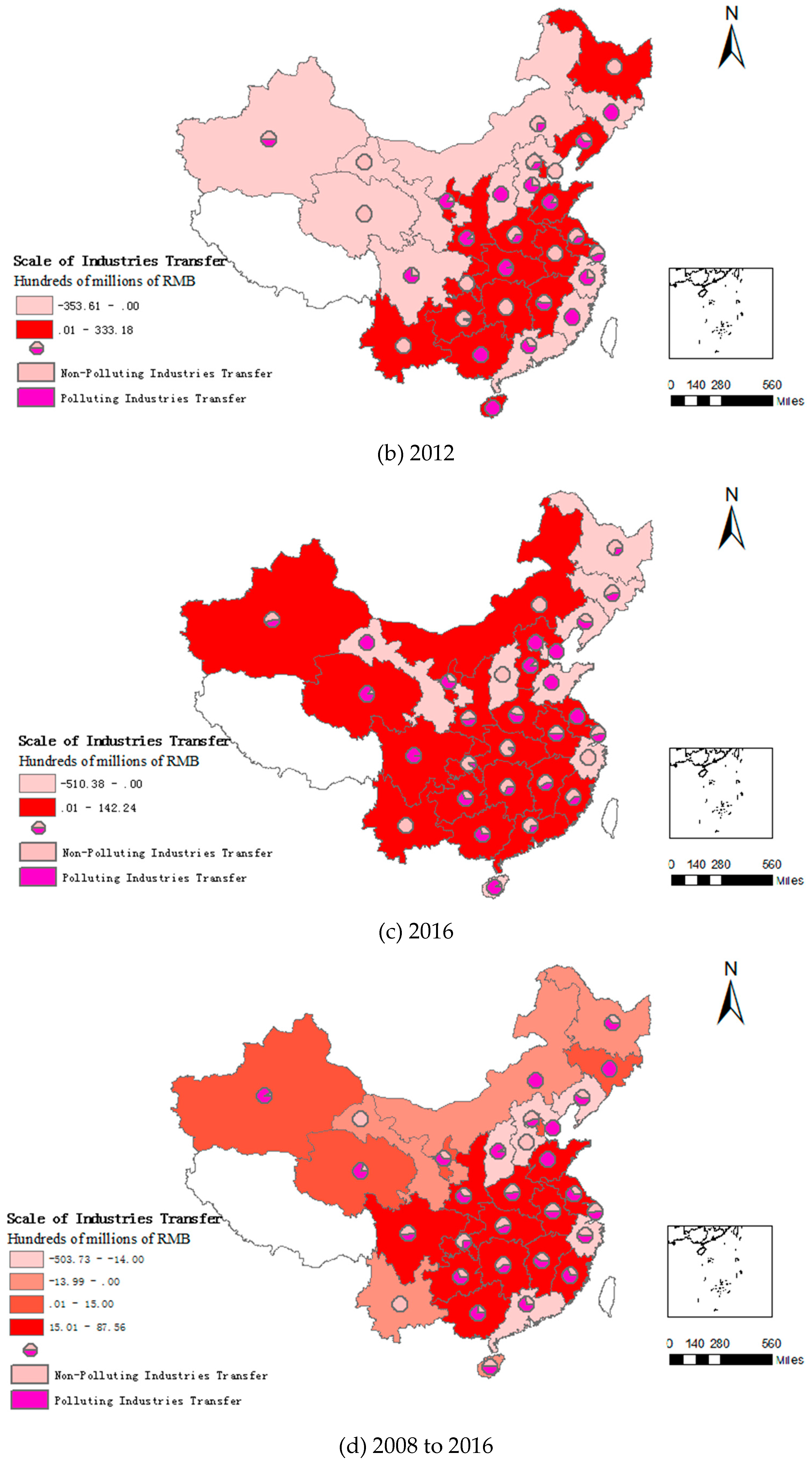
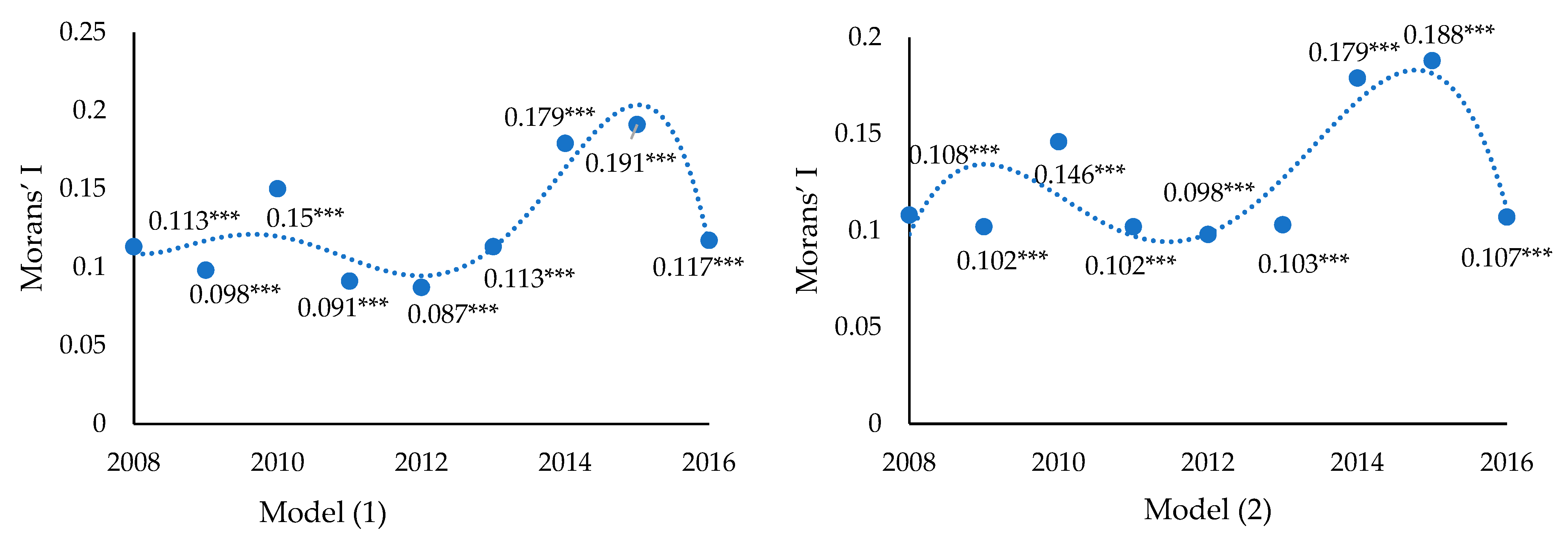
| Classification | Number | Industry |
|---|---|---|
| Non-polluting industry | 9 | Processing of Food from Agricultural Products (1); Manufacture of Foods (2); Manufacture of Tobacco (3); Manufacture of Textile (4); Manufacture of General Purpose Machinery (5); Manufacture of Special Purpose Machinery (6); Manufacture of Railway, Ship, Aerospace and Other Transport Equipments (7); Manufacture of Computers, Communication and Other Electronic Equipment (8); Manufacture of Measuring Instruments and Machinery (9) |
| Pollution industry | 11 | Manufacture of Liquor, Beverages and Refined Tea (10); Manufacture of Paper and Paper Products (11); Processing of Petroleum, Coking and Processing of Nuclear Fuel (12); Manufacture of Raw Chemical Materials and Chemical Products (13); Manufacture of Chemical Fibres (14); Manufacture of Non-metallic Mineral Products (15); Smelting and Pressing of Ferrous Metals (16); Smelting and Pressing of Non-ferrous Metals (17); Manufacture of Metal Products (18); Manufacture of Medicines (19); Manufacture of Electrical Machinery and Apparatus (20) |
| Variables | Symbol | Variable | Definition |
|---|---|---|---|
| Explanatory Variable | Y | PM10 Concentration | Annual PM10 Concentration in Provincial Cities |
| Core explanatory variable | IT | Industrial transfer level | Based on the shift-share method and entropy weight method, and the specific calculation steps are shown above |
| SIT | Industrial transfer scale | ||
| ITN | Non-polluting Industrial transfer level | ||
| SITN | Non-polluting industrial transfer Scale | ||
| ITP | Polluting Industrial transfer level | ||
| SITP | Polluting industrial transfer Scale | ||
| Control variable | POP | Population size. | Total population/administrative area |
| RGDP | Per capita GDP | GDP/total population | |
| SL | Stable lighting brightness | The logarithm of city road lighting | |
| EM | Energy mix | Coal consumption/total energy consumption (standard coal) | |
| ROAD | Vehicle use | Highway mileage/administrative area | |
| ER | Level of environmental regulation | Industrial pollution control investment /industrial added value | |
| SEC | Industrial structure | Industrial added value/GDP | |
| RAIN | Rainfall capacity | Average annual rainfall | |
| HUMIDITY | Relative humidity | Absolute humidity/saturated absolute humidity |
| Variables | Mean | Std. dev. | Min | Max |
|---|---|---|---|---|
| Y | 101.11 | 31.99 | 34 | 305 |
| IT | 0.652 | 0.140 | 0.415 | 1.484 |
| SIT | −17.111 | 290.037 | −4561.08 | 333.177 |
| ITN | 0.639 | 0.148 | 0.405 | 1.431 |
| SITN | 0.004 | 38.969 | −257.151 | 147.557 |
| ITP | 0.662 | 0.150 | 0.423 | 1.817 |
| SITP | −17.115 | 281.681 | −4552.76 | 285.445 |
| POP | 2791.789 | 1214.515 | 649 | 5967 |
| RGDP | 42675.15 | 22442.85 | 9855 | 118198 |
| SL | 13.159 | 0.742 | 11.086 | 15.068 |
| EM | 74.741 | 13.038 | 29.119 | 93.710 |
| ROAD | 13.814 | 23.167 | 0.083 | 125.397 |
| ER | 3.745 | 3.329 | 0.359 | 28.039 |
| SEC | 39.691 | 8.230 | 11.904 | 53.036 |
| RAIN | 950.842 | 569.967 | 148.8 | 2939.7 |
| HUMIDITY | 65.878 | 10.461 | 42 | 85 |
| Explanatory Variables | IT | SIT | POP | RGDP | SL | EM | ROAD | ER | SEC | RAIN | HUMIDITY | R−sq |
|---|---|---|---|---|---|---|---|---|---|---|---|---|
| Model (1) | 0.193 | 0.104 *** | 0.0231 | 0.0696 ** | 0.117 | 0.0215 | −0.0227 | 0.174 ** | −0.330 *** | −0.0453 | 0.510 | |
| (1.56) | (2.83) | (0.59) | (2.47) | (1.32) | (1.37) | (−0.98) | (2.12) | (−8.07) | (−0.27) | |||
| Model (2) | 0.00702 | 0.100 *** | 0.0205 | 0.0906 *** | 0.0809 | 0.0256 | −0.0229 | 0.181 ** | −0.330 *** | −0.0778 | 0.510 | |
| (1.57) | (2.73) | (0.52) | (3.58) | (0.91) | (1.61) | (−0.99) | (2.20) | (−8.08) | (−0.45) |
| Year | Morans’I | E (I) | Sd (I) | z | p-Value |
|---|---|---|---|---|---|
| 2008 | 0.079 | −0.033 | 0.047 | 2.406 | 0.008 |
| 2009 | 0.151 | −0.033 | 0.047 | 3.953 | 0.000 |
| 2010 | 0.128 | −0.033 | 0.047 | 3.457 | 0.000 |
| 2011 | 0.109 | −0.033 | 0.046 | 3.074 | 0.001 |
| 2012 | 0.114 | −0.033 | 0.046 | 3.181 | 0.001 |
| 2013 | 0.226 | −0.033 | 0.045 | 5.788 | 0.000 |
| 2014 | 0.289 | −0.033 | 0.047 | 6.292 | 0.000 |
| 2015 | 0.259 | −0.033 | 0.047 | 6.256 | 0.000 |
| 2016 | 0.303 | −0.033 | 0.047 | 7.180 | 0.000 |
| Explanatory Variables | Overall Industrial Transfer Level | Overall Industrial Transfer Scale | ||||||
|---|---|---|---|---|---|---|---|---|
| SEM | SAR | SAC | SDM | SEM | SAR | SAC | SDM | |
| Model (3) | Model (4) | Model (5) | Model (6) | Model (7) | Model (8) | Model (9) | Model (10) | |
| or | 0.186 | 0.300 * | 0.343 ** | 0.300 * | 0.175 | 0.300 * | 0.346 ** | 0.300 * |
| (1.03) | (1.66) | (1.99) | (1.67) | (0.96) | (1.66) | (2.01) | (1.67) | |
| IT | 0.265 ** | 0.263 ** | 0.264 ** | 0.209 ** | ||||
| (2.26) | (2.21) | (2.26) | (2.09) | |||||
| SIT | 0.00548 | 0.00562 | 0.00564 | 0.00612 * | ||||
| (1.34) | (1.36) | (1.39) | (1.85) | |||||
| POP | 0.073 ** | 0.0742 ** | 0.0745 ** | 0.181 *** | 0.0647 ** | 0.0663 ** | 0.0666 ** | 0.189 *** |
| (2.33) | (2.35) | (2.38) | (5.11) | (2.08) | (2.11) | (2.13) | (5.35) | |
| RGDP | −0.0717 | −0.0740 | −0.0739 | −0.0352 | −0.0834 | −0.0856 | −0.0855 | −0.0390 |
| (−1.29) | (−1.31) | (−1.34) | (−0.76) | (−1.49) | (−1.52) | (−1.54) | (−0.85) | |
| SL | 0.0497 * | 0.0501 * | 0.0496 * | −0.0386 | 0.0763 *** | 0.0769 *** | 0.0763 *** | −0.0105 |
| (1.91) | (1.92) | (1.86) | (−1.45) | (3.14) | (3.15) | (3.07) | (−0.41) | |
| EM | 0.0538 | 0.0512 | 0.0515 | 0.195** | 0.0118 | 0.00971 | 0.00992 | 0.174* |
| (0.53) | (0.50) | (0.51) | (2.13) | (0.12) | (0.09) | (0.10) | (1.93) | |
| ROAD | 0.0262 * | 0.0266 * | 0.0269 * | 0.045 *** | 0.0320 ** | 0.0322 ** | 0.0325 ** | 0.054 *** |
| (1.87) | (1.90) | (1.93) | (3.26) | (2.29) | (2.33) | (2.35) | (4.07) | |
| ER | −0.08 *** | −0.08 *** | −0.08 *** | −0.0193 | −0.082 *** | −0.079 *** | −0.079 *** | −0.017 |
| (−3.70) | (−3.49) | (−3.52) | (−0.99) | (−3.66) | (−3.47) | (−3.50) | (−0.88) | |
| SEC | 0.219 *** | 0.222 *** | 0.224 *** | 0.368 *** | 0.242 *** | 0.244 *** | 0.245 *** | 0.343 *** |
| (2.71) | (2.73) | (2.73) | (3.99) | (3.01) | (3.00) | (3.01) | (3.72) | |
| RAIN | −0.33 *** | −0.32 *** | −0.32 *** | −0.25 *** | −0.33 *** | −0.32 *** | −0.32 *** | −0.26 *** |
| (−8.13) | (−7.80) | (−7.98) | (−6.09) | (−8.06) | (−7.74) | (−7.92) | (−6.27) | |
| HUMIDITY | −0.171 | −0.136 | −0.139 | 0.654 *** | −0.201 | −0.166 | −0.169 | 0.622 *** |
| (−1.06) | (−0.83) | (−0.87) | (4.21) | (−1.23) | (−1.01) | (−1.05) | (4.02) | |
| W×T | 0.697 | |||||||
| (0.96) | ||||||||
| W×SIT | 0.049 ** | |||||||
| (2.06) | ||||||||
| R2 | 0.733 | 0.743 | 0.744 | 0.885 | 0.724 | 0.735 | 0.736 | 0.885 |
| Log−L | 53.127 | 55.539 | 55.466 | 119.059 | 51.489 | 53.986 | 53.903 | 120.063 |
| AIC | −82.127 | −87.078 | −84.931 | −194.12 | −78.978 | −83.972 | −81.806 | −196.126 |
| BIC | −39.073 | −43.897 | −38.152 | −114.95 | −35.797 | −40.791 | −35.027 | −116.961 |
| Year | Yes | Yes | Yes | Yes | Yes | Yes | Yes | Yes |
| Explanatory Variables | Model (6) | Model (10) | ||||
|---|---|---|---|---|---|---|
| Direct Effects | Indirect Effects | Total Effects | Direct Effects | Indirect Effects | Total Effects | |
| IT | 0.226 ** | 1.166 | 1.392 | |||
| (2.04) | (0.84) | (0.95) | ||||
| SIT | 0.00731 ** | 0.0774 | 0.0847 | |||
| (1.97) | (1.44) | (1.52) | ||||
| POP | 0.221 *** | 2.371 * | 2.592 * | 0.232 *** | 2.544 * | 2.776 ** |
| (3.62) | (1.84) | (1.93) | (3.70) | (1.89) | (1.98) | |
| RGDP | −0.00715 | 1.619 * | 1.612 | −0.0108 | 1.621 * | 1.610 |
| (−0.13) | (1.70) | (1.63) | (−0.20) | (1.71) | (1.63) | |
| SL | −0.0698 * | 1.821 ** | 1.75 ** | −0.0383 | 1.598 ** | 1.559 ** |
| (−1.73) | (2.38) | (2.37) | (−1.04) | (2.41) | (2.36) | |
| EM | 0.243 ** | 2.625 | 2.869 | 0.224 ** | 2.732 | 2.957 |
| (2.20) | (1.53) | (1.61) | (2.02) | (1.58) | (1.64) | |
| ROAD | 0.0555 *** | 0.636 ** | 0.692 ** | 0.0656 *** | 0.690 ** | 0.755 ** |
| (3.42) | (2.40) | (2.51) | (4.05) | (2.41) | (2.54) | |
| ER | −0.0166 | 0.148 | 0.132 | −0.0142 | 0.161 | 0.146 |
| (−0.80) | (0.72) | (0.62) | (−0.68) | (0.79) | (0.69) | |
| SEC | 0.396 *** | 1.771 | 2.167 * | 0.361 *** | 1.186 | 1.547 |
| (3.72) | (1.60) | (1.83) | (3.46) | (1.15) | (1.40) | |
| RAIN | −0.267 *** | −0.951 * | −1.22 ** | −0.278 *** | −1.148 ** | −1.43 ** |
| (−6.57) | (−1.86) | (−2.33) | (−6.62) | (−1.98) | (−2.39) | |
| HUMIDITY | 0.665 *** | 0.370 | 1.035 | 0.635 *** | 0.497 | 1.132 |
| (4.37) | (0.22) | (0.61) | (4.18) | (0.30) | (0.67) | |
| Explanatory Variables | Non−Polluting Industries Transfer | Polluting Industries Transfer | ||
|---|---|---|---|---|
| SDM | SDM | SDM | SDM | |
| Model (11) | Model (12) | Model (13) | Model (14) | |
| or | 0.300 * | 0.626 *** | 0.300 | 0.300 * |
| (1.67) | (7.47) | (1.67) | (1.67) | |
| ITN | 0.143 | / | / | / |
| (1.60) | ||||
| SITN | / | 0.00376 | / | / |
| (1.02) | ||||
| ITP | / | / | 0.200 * | / |
| (2.15) | ||||
| SITP | / | / | / | 0.00998 *** |
| (2.75) | ||||
| POP | 0.183 *** | 0.169 *** | 0.177 *** | 0.200 *** |
| (5.16) | (3.51) | (4.98) | (5.72) | |
| RGDP | −0.0431 | −0.101 | −0.0354 | −0.0245 |
| (−0.93) | (−1.14) | (−0.77) | (−0.55) | |
| SL | −0.0335 | 0.00744 | −0.0375 | −0.00826 |
| (−1.27) | (0.17) | (−1.43) | (−0.33) | |
| EM | 0.203 ** | 0.220 ** | 0.181 * | 0.172 * |
| (2.21) | (2.06) | (1.99) | (1.93) | |
| ROAD | 0.0491 *** | 0.0528 * | 0.0421 ** | 0.0579 *** |
| (3.62) | (1.81) | (3.01) | (4.24) | |
| ER | −0.0226 | 0.00484 | −0.0170 | 0.0248 |
| (−1.16) | (0.29) | (−0.87) | (0.86) | |
| SEC | 0.365 *** | 0.175 * | 0.380 *** | 0.351 *** |
| (3.97) | (1.93) | (4.14) | (3.89) | |
| RAIN | −0.252 *** | −0.100 ** | −0.248 *** | −0.252 *** |
| (−6.06) | (−2.54) | (−6.01) | (−6.28) | |
| HUMIDITY | 0.643 *** | 0.112 | 0.656 *** | 0.594 *** |
| (4.12) | (0.63) | (4.23) | (4.03) | |
| W×ITN | 0.231 | / | / | / |
| (0.34) | ||||
| W×SITN | / | 0.0687 *** (2.97) | / | / |
| W×ITP | / | / | 0.887 (1.43) | / |
| W×SITP | / | / | / | 1.142 *** (3.07) |
| R2 | 0.8833 | 0.7052 | 0.8854 | 0.8883 |
| Log−L | 118.1496 | 156.4110 | 119.5896 | 123.0386 |
| AIC | −195.1792 | −264.8221 | −192.2992 | −202.0771 |
| BIC | −116.014 | −178.4599 | −113.134 | −122.9119 |
| Year | Yes | Yes | Yes | Yes |
| Explanatory Variables | Model (11) | Model (12) | Model (13) | Model (14) | ||||||||
|---|---|---|---|---|---|---|---|---|---|---|---|---|
| Direct Effects | Indirect Effects | Total Effects | Direct Effects | Indirect Effects | Total Effects | Direct Effects | Indirect Effects | Total Effects | Direct Effects | Indirect Effects | Total Effects | |
| ITN | 0.147 | 0.411 | 0.558 | |||||||||
| (1.48) | (0.34) | (0.44) | ||||||||||
| SITN | 0.00822 | 0.0826 | 0.0908 | |||||||||
| (1.37) | (1.32) | (1.39) | ||||||||||
| ITP | 0.222** | 1.460 | 1.682 | |||||||||
| (2.18) | (1.14) | (1.26) | ||||||||||
| SITP | 0.0115 *** | 0.120 * | 0.132 * | |||||||||
| (2.68) | (1.69) | (1.79) | ||||||||||
| POP | 0.223 *** | 2.420 * | 2.644 * | 0.233 *** | 2.581 * | 2.815 ** | 0.215 *** | 2.312 * | 2.528 * | 0.242 *** | 2.641 * | 2.883 ** |
| (3.61) | (1.84) | (1.93) | (3.66) | (1.88) | (1.96) | (3.57) | (1.83) | (1.92) | (3.85) | (1.95) | (2.04) | |
| RGDP | −0.0168 | 1.516 | 1.500 | −0.00927 | 1.646 * | 1.636 | −0.00705 | 1.637* | 1.630 | −0.00171 | 1.811 * | 1.813 * |
| (−0.31) | (1.64) | (1.56) | (−0.17) | (1.69) | (1.62) | (−0.13) | (1.71) | (1.64) | (−0.03) | (1.81) | (1.75) | |
| SL | −0.0635 | 1.75 ** | 1.69 ** | −0.0358 | 1.62 ** | 1.58 ** | −0.0692 * | 1.86 ** | 1.79 ** | −0.0366 | 1.57 ** | 1.533 ** |
| (−1.61) | (2.37) | (2.36) | (−0.96) | (2.40) | (2.35) | (−1.72) | (2.40) | (2.38) | (−1.02) | (2.42) | (2.37) | |
| EM | 0.253 ** | 2.714 | 2.967 | 0.223 ** | 2.551 | 2.774 | 0.229 ** | 2.586 | 2.815 | 0.263 ** | 3.207 * | 3.470 * |
| (2.27) | (1.56) | (1.63) | (2.02) | (1.50) | (1.56) | (2.08) | (1.52) | (1.59) | (2.34) | (1.74) | (1.80) | |
| ROAD | 0.0602 *** | 0.666 ** | 0.726 ** | 0.0646 *** | 0.673 ** | 0.737 ** | 0.0524 *** | 0.613 ** | 0.665 ** | 0.0661 *** | 0.678 ** | 0.745 ** |
| (3.72) | (2.42) | (2.54) | (4.00) | (2.40) | (2.53) | (3.21) | (2.38) | (2.48) | (4.16) | (2.42) | (2.56) | |
| ER | −0.0200 | 0.144 | 0.124 | −0.0139 | 0.197 | 0.183 | −0.0143 | 0.151 | 0.137 | −0.0138 | 0.142 | 0.128 |
| (−0.97) | (0.70) | (0.58) | (−0.67) | (0.94) | (0.84) | (−0.69) | (0.74) | (0.65) | (−0.68) | (0.71) | (0.61) | |
| SEC | 0.392 *** | 1.733 | 2.125 * | 0.353 *** | 1.228 | 1.581 | 0.408 *** | 1.824 | 2.232 * | 0.328 *** | 0.789 | 1.117 |
| (3.70) | (1.58) | (1.81) | (3.33) | (1.17) | (1.40) | (3.85) | (1.63) | (1.87) | (3.17) | (0.79) | (1.04) | |
| RAIN | −0.267 *** | −0.913 * | −1.18 ** | −0.280 *** | −1.081 * | −1.36 ** | −0.263 *** | −0.963 * | −1.23 ** | −0.281 *** | −1.28 ** | −1.56 ** |
| (−6.55) | (−1.83) | (−2.31) | (−6.67) | (−1.93) | (−2.36) | (−6.50) | (−1.87) | (−2.33) | (−6.61) | (−2.08) | (−2.47) | |
| HUMIDITY | 0.650 *** | 0.152 | 0.802 | 0.664 *** | 0.435 | 1.099 | 0.668 *** | 0.456 | 1.124 | 0.641 *** | 0.833 | 1.474 |
| (4.26) | (0.09) | (0.48) | (4.37) | (0.26) | (0.65) | (4.41) | (0.27) | (0.66) | (4.25) | (0.50) | (0.86) | |
| Explanatory Variables | IT | SIT | ITN | SITN | ITP | SITP |
|---|---|---|---|---|---|---|
| Model (15) | Model (16) | Model (17) | Model (18) | Model (19) | Model (20) | |
| or | 0.467 *** | 0.462 *** | 0.597 *** | 0.607 *** | 0.471 *** | 0.457 *** |
| (5.17) | (5.10) | (9.22) | (9.81) | (5.24) | (5.03) | |
| IT | 0.179 ** | |||||
| (1.98) | ||||||
| SIT | 0.00535 * | |||||
| (1.73) | ||||||
| ITN | 0.0330 | |||||
| (0.44) | ||||||
| SITN | 0.00107 | |||||
| (0.31) | ||||||
| ITP | 0.129 ** | |||||
| (2.64) | ||||||
| SITP | 0.00735 ** | |||||
| (2.12) | ||||||
| POP | 0.0943 *** | 0.0992 *** | 0.116 *** | 0.122 *** | 0.0950 *** | 0.102 *** |
| (3.55) | (3.75) | (2.75) | (2.93) | (3.57) | (3.86) | |
| RGDP | −0.116 *** | −0.116 *** | −0.125 *** | −0.130 *** | −0.123 *** | −0.116 *** |
| (−2.66) | (−2.69) | (−2.50) | (−2.59) | (−2.83) | (−2.70) | |
| SL | 0.0365 | 0.0570 | 0.0690 | 0.0684 | 0.0396 | 0.0557 |
| (1.53) | (1.47) | (1.48) | (1.54) | (1.47) | (1.43) | |
| EM | 0.0368 ** | 0.00927 ** | 0.131 | 0.105 | 0.0438 | 0.0256 |
| (2.44) | (2.11) | (1.30) | (1.06) | (0.53) | (0.31) | |
| ROAD | 0.0241 * | 0.0306 ** | 0.0211 | 0.0308 | 0.0277 ** | 0.0309 ** |
| (1.94) | (2.53) | (0.84) | (1.25) | (2.26) | (2.57) | |
| ER | −0.0187 | −0.0155 | 0.00454 | 0.0114 | −0.0217 | −0.0167 |
| (−1.04) | (−0.85) | (0.28) | (0.71) | (−1.20) | (−0.93) | |
| SEC | 0.343 *** | 0.339 *** | 0.194 ** | 0.206 *** | 0.341 *** | 0.333 *** |
| (3.99) | (3.97) | (2.43) | (2.58) | (3.97) | (3.91) | |
| RAIN | −0.223 *** | −0.218 *** | −0.082 ** | −0.084 ** | −0.219 *** | −0.214 *** |
| (−5.64) | (−5.55) | (−2.09) | (−2.15) | (−5.53) | (−5.46) | |
| HUMIDITY | 0.711 *** | 0.671 *** | 0.168 | 0.137 | 0.696 *** | 0.665 *** |
| (4.54) | (4.30) | (0.93) | (0.76) | (4.42) | (4.27) | |
| W×IT | 0.321 | |||||
| (1.07) | ||||||
| W×SIT | 0.0140 | |||||
| (1.56) | ||||||
| W×ITN | −0.158 | |||||
| (−0.92) | ||||||
| W×SITN | 0.0213 ** (2.44) | |||||
| W×ITP | 0.0538 | |||||
| (0.19) | ||||||
| W×SITP | 0.0157 | |||||
| (1.51) | ||||||
| R2 | 0.8875 | 0.8872 | 0.7403 | 0.7367 | 0.8841 | 0.8889 |
| Log−L | 130.0786 | 130.7456 | 158.9032 | 161.3626 | 129.0536 | 131.7788 |
| AIC | −216.1571 | −217.4912 | −269.806 | −274.725 | −214.1072 | −219.5577 |
| BIC | −136.9918 | −138.3259 | −183.444 | −188.363 | −134.9419 | −140.3924 |
| Year | Yes | Yes | Yes | Yes | Yes | Yes |
© 2019 by the authors. Licensee MDPI, Basel, Switzerland. This article is an open access article distributed under the terms and conditions of the Creative Commons Attribution (CC BY) license (http://creativecommons.org/licenses/by/4.0/).
Share and Cite
Liu, Y.; Dong, F. How Industrial Transfer Processes Impact on Haze Pollution in China: An Analysis from the Perspective of Spatial Effects. Int. J. Environ. Res. Public Health 2019, 16, 423. https://doi.org/10.3390/ijerph16030423
Liu Y, Dong F. How Industrial Transfer Processes Impact on Haze Pollution in China: An Analysis from the Perspective of Spatial Effects. International Journal of Environmental Research and Public Health. 2019; 16(3):423. https://doi.org/10.3390/ijerph16030423
Chicago/Turabian StyleLiu, Yajie, and Feng Dong. 2019. "How Industrial Transfer Processes Impact on Haze Pollution in China: An Analysis from the Perspective of Spatial Effects" International Journal of Environmental Research and Public Health 16, no. 3: 423. https://doi.org/10.3390/ijerph16030423
APA StyleLiu, Y., & Dong, F. (2019). How Industrial Transfer Processes Impact on Haze Pollution in China: An Analysis from the Perspective of Spatial Effects. International Journal of Environmental Research and Public Health, 16(3), 423. https://doi.org/10.3390/ijerph16030423






